Last Updated on: September 1, 2025Worried about your floodlights failing early? You see them dim or die, costing you money and client trust. The secret to long life lies in proper heat dissipation.
Excellent heat dissipation is critical for floodlight performance. It directly impacts brightness, color consistency, and lifespan. Poor heat management causes LEDs to dim faster, shift color, and fail prematurely. A good heatsink is essential for a reliable floodlight that performs as promised for years.
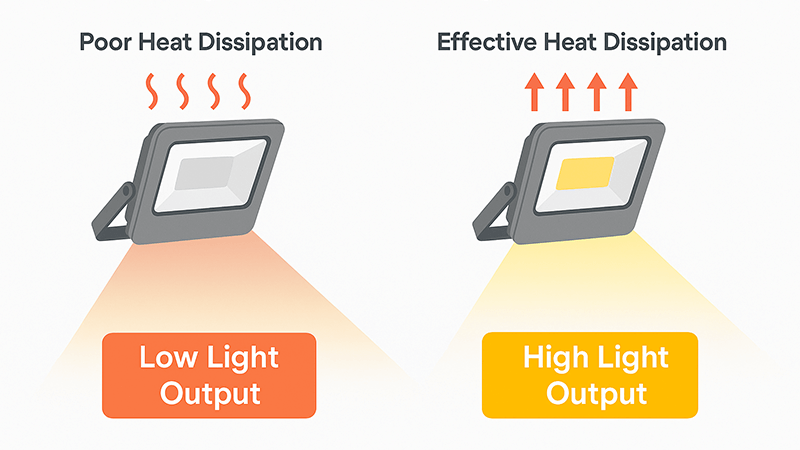
Over my years in the LED lighting industry, I’ve seen countless projects succeed or fail based on this one factor: heat. It’s often overlooked, but it’s the silent killer of LED performance. For a purchasing manager like Shaz in a hot climate like the UAE, this is even more critical. Let’s break down why heat is such a big deal and what you, as a buyer, can do about it. It all starts with understanding the source of the problem.
Do Floodlights Actually Generate Heat?
Many believe LEDs run completely cool. This assumption leads to buying lights that overheat and fail. The truth is, all LED floodlights produce heat that must be managed.
Yes, all floodlights generate heat. While LEDs are much more efficient than old technologies like halogen, they still convert a portion of electrical energy into heat, not light. This heat, if not managed, gets trapped in the fixture and damages the sensitive electronic components inside.
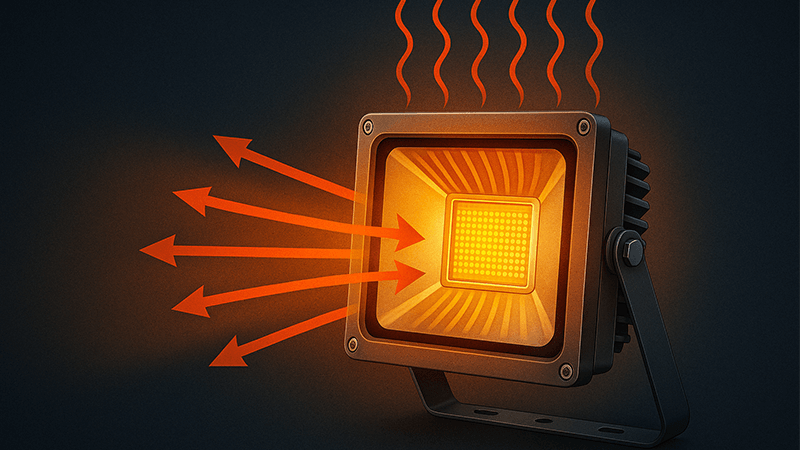
People often say LEDs are cool to the touch. This is partly true compared to an old halogen bulb that could burn you. But it’s a dangerous oversimplification when selecting professional-grade lighting. Every electronic device that uses electricity creates some heat, and LED floodlights are no exception. The real issue isn’t if they generate heat, but how much and what happens to it.
The Source of the Heat in an LED Fixture
An LED, or Light Emitting Diode, is a semiconductor device. When electricity passes through the LED chip’s PN junction, it excites electrons. These electrons then release energy as photons—the light particles we see. However, this process is not 100% efficient. A good portion of the electrical energy is lost and converted directly into heat right at the chip level. On top of that, the LED driver is the power supply that converts AC power to the low-voltage DC power the LEDs need. It also generates its own heat as it works. Both of these heat sources are contained within the sealed floodlight housing.
Efficiency and Heat: A Quick Comparison
Unlike an old bulb that radiates most of its heat out into the air, an LED traps this heat internally around the chip. This makes removing it much more important.
| Light Source |
Approximate Light Efficiency |
Approximate Heat Output |
| Incandescent Bulb |
~5% |
~95% |
| Halogen Bulb |
~10% |
~90% |
| LED Floodlight |
~40-60% |
~40-60% |
As you can see, even a highly efficient LED floodlight still converts a large chunk of energy into heat. If this heat cannot escape the fixture, the temperature inside builds up quickly. This is especially dangerous in hot climates like the UAE. When the outside ambient temperature is already 45°C, a poorly designed heatsink simply can’t get rid of the internal heat fast enough. This leads to component degradation and eventually, total failure.
How Can You Calculate the Heat Dissipation of LED Lights?
You need to compare the cooling ability of different floodlights. But complex thermal calculations are overwhelming. I’ll give you practical ways to judge heat dissipation without complex engineering formulas.
Calculating precise heat dissipation requires complex thermal modeling. A more practical method for a buyer is to assess the heatsink’s design and materials. For the same wattage, a heavier floodlight usually means a bigger, better heatsink made from more aluminum, which is a good sign.
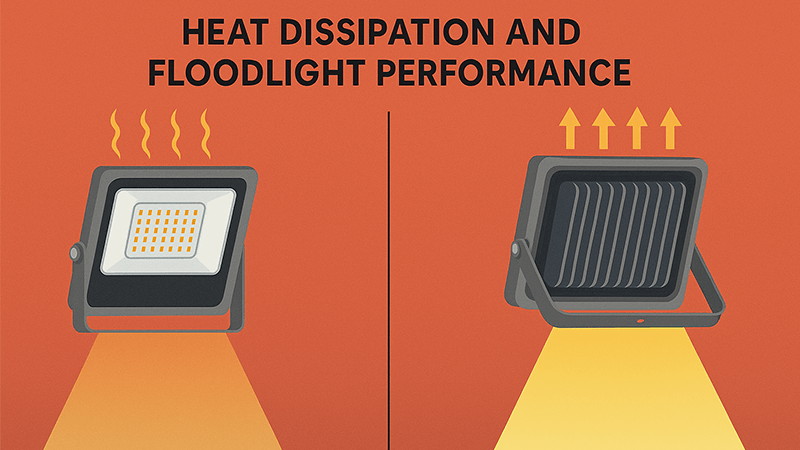
While my engineers use complex software to model thermal resistance and airflow, that’s not practical for a purchasing manager on the ground. You don’t need to be a thermal engineer to make a smart choice. After years of manufacturing and seeing what works, I’ve learned to rely on simple, physical checks that tell me 90% of the story about a floodlight’s cooling capability.
Your Practical Heatsink Evaluation Guide
The most important component for heat dissipation is the heatsink. In a floodlight, this is usually the main body of the fixture itself. Its job is to draw heat away from the LED chip and driver and release it into the surrounding air. Here’s how you can judge its quality with your own hands and eyes.
-
Feel the Weight: This is my number one rule. Take two floodlights with the same power rating, for example, 150W. Pick them both up. The heavier one almost always has a better heatsink. More weight means more die-cast aluminum was used in the housing. More aluminum means more mass to absorb heat spikes and more surface area to dissipate that heat. When a manufacturer wants to cut costs, the first thing they do is reduce the amount of aluminum in the housing.
-
Examine the Design: Look at the fins on the back of the floodlight. Are they deep? Are there many of them? These fins are not just for looks; they dramatically increase the surface area of the heatsink. More surface area in contact with the air means faster, more efficient cooling. A floodlight with a flat, smooth back will perform much worse than one with a well-designed, finned structure.
The Buyer’s Heatsink Checklist
| Feature to Check |
What to Look For |
Why It Matters |
| Weight |
For the same wattage, heavier is better. |
Indicates more cooling material (aluminum). |
| Fins |
Deep, numerous, and well-spaced fins. |
Increases surface area for heat to escape into the air. |
| Material |
Solid, die-cast aluminum is the best choice. |
Provides good thermal conductivity and structural durability. |
| Finish |
A quality powder coat or anodized finish. |
Protects against corrosion, which can insulate the metal and degrade thermal performance over time. |
I remember a client in a very hot region who was tempted by a very low-cost 200W floodlight. It was almost half the weight of our iPHD model. I warned him that the weight difference was pure heatsink material. Sure enough, his project faced massive failures within a year because the lights couldn’t survive the summer heat. The small saving upfront cost him a fortune in replacements and damaged his reputation.
Why Do My LED Floodlights Fail So Quickly?
Your LED floodlights promised 50,000 hours, but they’re dying in a fraction of that time. This is a frustrating and expensive problem. The reason is usually a few key weak points.
The number one reason for early LED floodlight failure is excessive heat buildup due to a poor heatsink design. This heat damages the LED chips, causing them to dim or flicker, and critically, it destroys the driver (power supply), which is the most common point of failure.
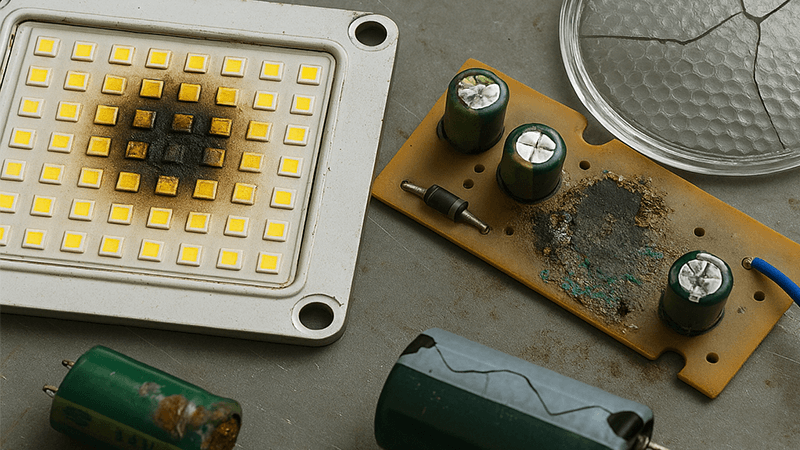
It’s a common story I hear from buyers like Shaz. They are promised a long lifespan but face early failures. The marketing says 50,000 hours, but reality hits much sooner. In almost every case I’ve investigated, I can trace the failure back to shortcuts taken by the manufacturer to save a few dollars. Heat is the primary weapon that exposes all these hidden weaknesses.
The Chain Reaction of Failure
When a floodlight has an undersized heatsink, it starts a chain reaction of failure. First, the operating temperature of the LED chips rises beyond its safe limit. This doesn’t make them fail instantly, but it makes them age much faster. The materials in the chip, like the phosphor coating, start to break down. This causes a permanent loss of brightness, which we call lumen depreciation. You’ll notice the light isn’t as bright as it was a year ago. The color can also shift, often becoming bluish or yellowish.
The Most Common Victim: The Driver
While the LEDs are slowly dimming, the driver is often what dies first and causes a complete failure. The driver is the floodlight’s power supply, and it’s full of heat-sensitive electronic components, especially electrolytic capacitors. There is a rule of thumb in electronics: for every 10°C increase in operating temperature, the lifespan of a capacitor is cut in half. A cheap driver with low-quality capacitors, combined with a bad heatsink that traps heat, is a recipe for disaster. The driver will overheat and fail, and the light will go out completely. This is, by far, the most common reason a "dead" LED floodlight is returned to me.
Other Quality-Related Failures
Heat isn’t the only killer, but it often helps other issues along. This is why checking the small details for signs of quality manufacturing is so important.
| Failure Point |
Cause |
How Heat Makes It Worse |
| Water Ingress |
Poorly made rubber seals or gaskets. |
Heat and UV exposure make cheap rubber gaskets brittle, causing them to crack and let in moisture, which shorts the electronics. Quality seals are made of silicone. |
| Flickering Light |
Low-quality driver components. |
Heat stress causes weak electronic components and bad solder joints in the driver to fail intermittently. |
| Component Burnout |
Undersized wires or bad soldering. |
High heat increases electrical resistance, leading to burnout at weak points in the circuit. |
When you inspect a floodlight, look closely at the workmanship. Are the seams between the housing parts tight and even? Is the gasket around the glass soft and flexible like silicone, or is it hard and plasticky? Are the wires thick and sturdy? These small details tell you a lot about the overall quality and how long the product will truly last in the field.
But Aren’t All LED Floodlights Energy Efficient?
The term "energy efficient" is used for all LEDs. But if a floodlight wastes energy as heat and fails quickly, are you really saving money? Let’s look beyond the label.
High-quality LED floodlights are very energy-efficient. However, efficiency is lost in two ways: low-quality drivers wasting power, and poor thermal management which converts more energy to heat instead of light. This reduces the total light output for the wattage you pay for.
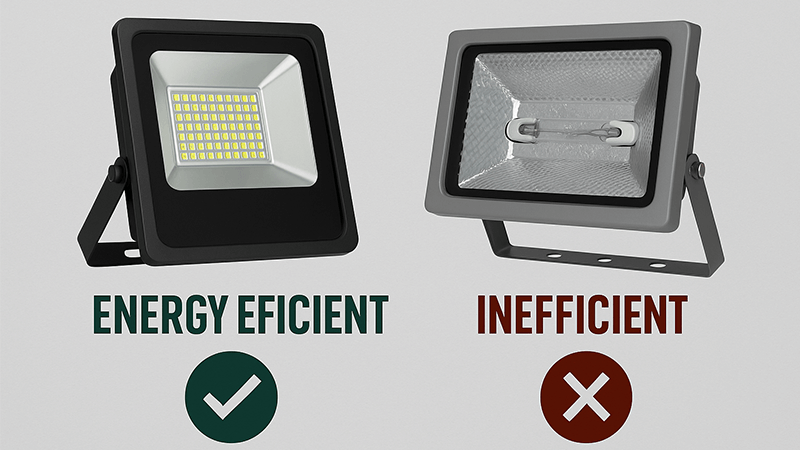
On paper, all LED technology is more efficient than what came before it. But in the real world of project specifications, there is a huge difference between a cheap LED floodlight and a quality one. True energy efficiency isn’t just about the initial power draw listed on the box; it’s about how much light you get for that power, and for how long that performance is maintained.
The Real Measure: Lumens per Watt
The most important metric for efficiency is luminous efficacy, which is measured in lumens per watt (lm/W). This number tells you exactly how much visible light is produced for every single watt of electricity consumed. The difference between products can be huge.
- A low-quality 100W floodlight might produce only 8,000 lumens. That’s an efficacy of 80 lm/W.
- A high-quality 100W floodlight can produce over 15,000 lumens. That’s an efficacy of 150 lm/W.
The high-quality light gives you nearly double the brightness for the exact same electricity bill. Put another way, you could use a 60W high-quality light to get more brightness than the 100W cheap light, saving 40% on your energy costs from day one.
How Heat Steals Your Efficiency and Money
This is where good heat dissipation proves its value again. As an LED chip gets hotter, its efficacy drops. That cheap floodlight with the poor heatsink might start at 80 lm/W when you first turn it on in a lab. But after an hour of running hot out in the field, its performance might drop to just 60 lm/W. It’s still drawing 100W of power from the wall, but now even more of that power is being wasted as heat instead of creating useful light. A well-designed floodlight with a heavy heatsink will maintain a stable, cool operating temperature and a stable, high light output.
Don’t Forget the Driver and Certifications
The driver’s efficiency also plays a huge role. A cheap driver might only be 85% efficient, meaning it wastes 15% of the power as heat before the electricity even reaches the LEDs. A high-quality driver from a reputable brand can be over 95% efficient. This not only saves energy but also means the driver itself runs cooler, extending its own life. This is why checking for certifications is a smart move. Product certifications like CE and RoHS are a must for export quality. For the driver specifically, look for marks like CQC, UL, or TÜV. These mean the driver has been independently tested for safety and performance claims. As I always say, "you get what you pay for." A price that is far below the market average always means corners were cut. Those cuts directly impact efficiency, performance, and lifespan, costing you far more in the long run.
Conclusion
In conclusion, effective heat dissipation is the defining factor for a floodlight’s performance, efficiency, and lifespan. Prioritize a quality heatsink to ensure your lighting investment truly lasts.